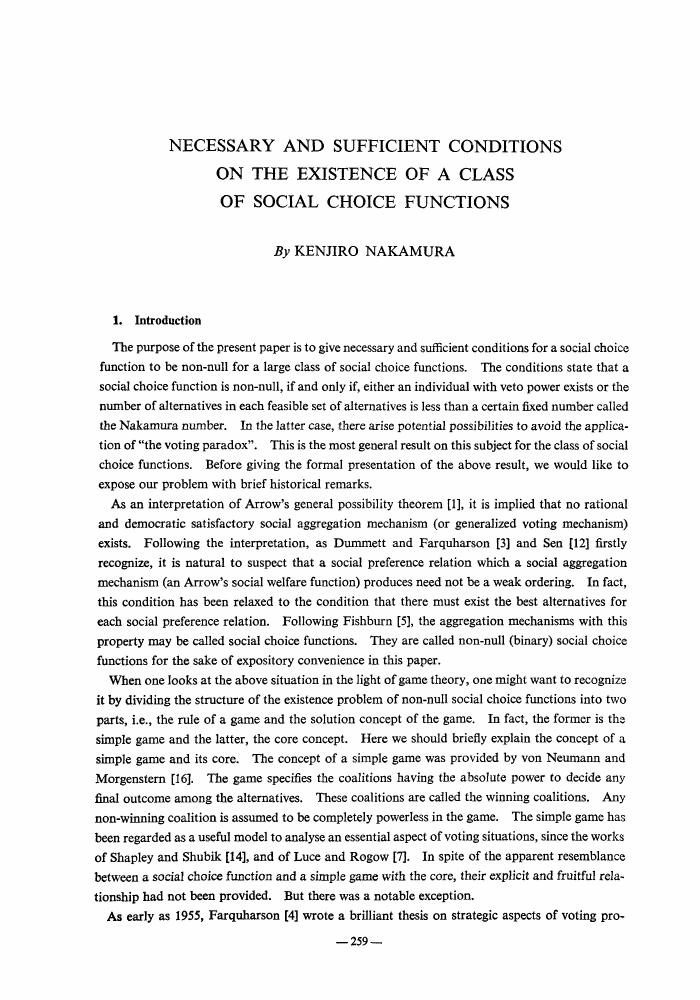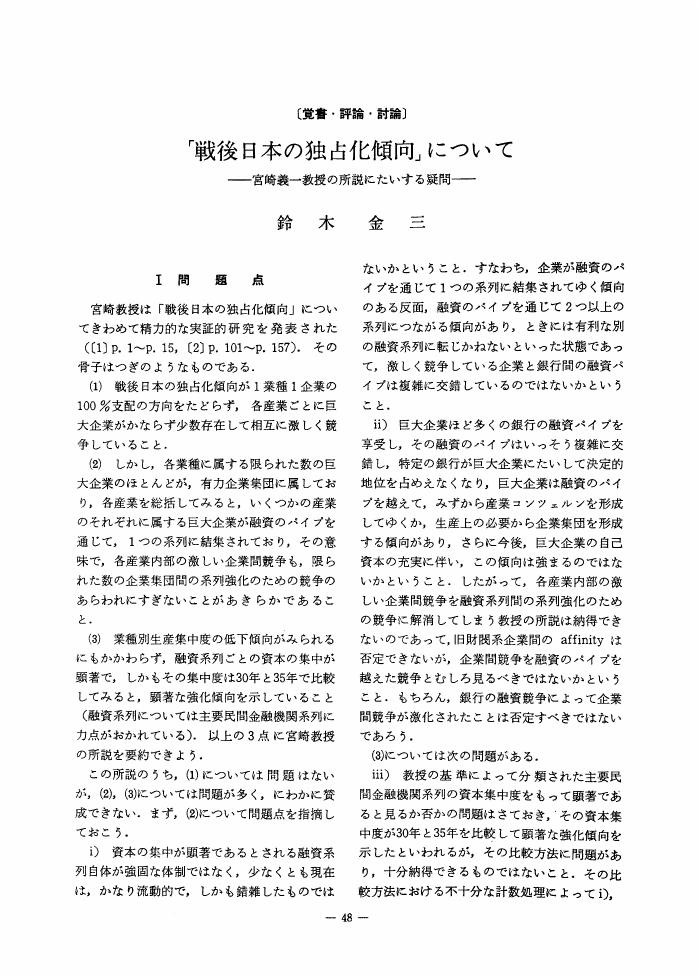- 著者
- HIROFUMI UZAWA
- 出版者
- JAPANESE ECONOMIC ASSOCIATION
- 雑誌
- 季刊 理論経済学 (ISSN:0557109X)
- 巻号頁・発行日
- vol.13, no.1, pp.59-62, 1962-09-30 (Released:2008-02-28)
- 参考文献数
- 12
THE PURPOSE of this note is to show the equivalence of two fundamental theorems-Walras' Existence Theorem on the one hand and Brouwer's FixedPoint Theorem on the other.Walras' theorem1) is concerned with the existence of an equilibrium in the Walrasian system of general equilibrium and has been a problem of some importance in formal economic analysis since his work [12] appeared in 1874-7. It was, however, not until Wald's contributions, [10] and [11], that the existence problem was rigorously treated. Recent contributions, in particular those of Arrow and Debreu [2], McKenzie [6], NikaidÔ [7], and Gale [4], have shown that Walras' theorem is essentially a necessary consequence of Brouwer's FixedPoint Theorem. The latter theorem, 2)first proved by Brouwer [3] in 1911, also bears a fundamental importance in mathematics. It may be hence of some interest to see that Brouwer's theorem is in fact implied by Walras' theorem. It would indicate the reason that the general treatment of the existence pro blem in the Walrasian system had to wait for the development of the twentieth century mathematics.
8 0 0 0 OA 塩沢由典「広義の生産の範囲での投下労働量」へのコメント
- 著者
- 藤本 喬雄
- 出版者
- 日本経済学会
- 雑誌
- 季刊 理論経済学 (ISSN:0557109X)
- 巻号頁・発行日
- vol.29, no.2, pp.179-182, 1978-08-31 (Released:2008-02-28)
- 参考文献数
- 13
6 0 0 0 OA 新古典学派と資本主義
- 著者
- 末永 隆甫
- 出版者
- 日本経済学会
- 雑誌
- 季刊 理論経済学 (ISSN:0557109X)
- 巻号頁・発行日
- vol.3, no.1, pp.19-29, 1952-08-08 (Released:2008-02-28)
4 0 0 0 OA KINDS OF RATIONALISM
- 著者
- FRIEDRICH A.von HAYEK
- 出版者
- JAPANESE ECONOMIC ASSOCIATION
- 雑誌
- 季刊 理論経済学 (ISSN:0557109X)
- 巻号頁・発行日
- vol.15, no.2, pp.1-12, 1965-03-30 (Released:2008-02-28)
3 0 0 0 OA ソ連小売物価指数と実質賃銀指数の推計
- 著者
- 丹羽 春喜
- 出版者
- 日本経済学会
- 雑誌
- 季刊 理論経済学 (ISSN:0557109X)
- 巻号頁・発行日
- vol.12, no.3, pp.16-34, 1962-06-30 (Released:2008-02-28)
3 0 0 0 OA 「下村モデル」へのコメント
- 著者
- 馬場 啓之助
- 出版者
- 日本経済学会
- 雑誌
- 季刊 理論経済学 (ISSN:0557109X)
- 巻号頁・発行日
- vol.11, no.3-4, pp.18-18, 1961-03-25 (Released:2008-02-28)
2 0 0 0 OA 産関数と技術進歩 展望
2 0 0 0 OA 新古典派成長の病理
- 著者
- 二階堂 副包
- 出版者
- 日本経済学会
- 雑誌
- 季刊 理論経済学 (ISSN:0557109X)
- 巻号頁・発行日
- vol.30, no.1, pp.1-9, 1979-04-27 (Released:2007-10-18)
- 参考文献数
- 4
Pathology inherent to neoclassical equilibrium growth is diagnosed to reveal its instability by imbedding it in a Harrodian growth process in a disequilibrium dynamics setting. Despite the alleged stabilizing effect of smooth factor substitution it proves to be balanced just on a knifeedge. Once off the dead center the economy eventually suffers from either growth with prolonged inflation or secular depression. The malignancy is due to firms' investment behaviors, that can not be cured even by smooth factor substitution.
2 0 0 0 OA NECESSARY AND SUFFICIENT CONDITIONS ON THE EXISTENCE OF A CLASS OF SOCIAL CHOICE FUNCTIONS
- 著者
- KENJIRO NAKAMURA
- 出版者
- JAPANESE ECONOMIC ASSOCIATION
- 雑誌
- 季刊 理論経済学 (ISSN:0557109X)
- 巻号頁・発行日
- vol.29, no.3, pp.259-267, 1978-12-29 (Released:2008-02-28)
- 参考文献数
- 17
2 0 0 0 OA 安井琢麿教授と一般均衡理論の発展
- 著者
- 根岸 隆
- 出版者
- 日本経済学会
- 雑誌
- 季刊 理論経済学 (ISSN:0557109X)
- 巻号頁・発行日
- vol.23, no.1, pp.19-27, 1972-05-20 (Released:2008-02-28)
2 0 0 0 OA 柴田敬氏の「ヒックス循環論批判」
- 著者
- 安井 琢磨
- 出版者
- 日本経済学会
- 雑誌
- 季刊 理論経済学 (ISSN:0557109X)
- 巻号頁・発行日
- vol.3, no.3-4, pp.232-234, 1952-11-30 (Released:2008-02-28)
2 0 0 0 OA 書評
- 著者
- 岸本 哲也
- 出版者
- 日本経済学会
- 雑誌
- 季刊 理論経済学 (ISSN:0557109X)
- 巻号頁・発行日
- vol.36, no.3, pp.263-264, 1985-12-26 (Released:2007-10-18)
1 0 0 0 OA 「戦後日本の独占化傾向」について 宮崎義一教授の所説にたいする疑問
- 著者
- 鈴木 金三
- 出版者
- 日本経済学会
- 雑誌
- 季刊 理論経済学 (ISSN:0557109X)
- 巻号頁・発行日
- vol.13, no.2, pp.48-57, 1963-02-13 (Released:2008-02-28)
- 参考文献数
- 7
- 著者
- 江見 康一
- 出版者
- JAPANESE ECONOMIC ASSOCIATION
- 雑誌
- 季刊 理論経済学 (ISSN:0557109X)
- 巻号頁・発行日
- vol.22, no.3, pp.76-77, 1971
1 0 0 0 下村博士への回答:マーティン•ブロンフェンブレンナー
- 著者
- 藤野 志朗
- 出版者
- 日本経済学会
- 雑誌
- 季刊 理論経済学 (ISSN:0557109X)
- 巻号頁・発行日
- vol.15, no.3, pp.68-69, 1965
1 0 0 0 OA レオンティエフ体系における均衡値問題(その一) 生産係数の安定性
- 著者
- 稻田 獻一
- 出版者
- 日本経済学会
- 雑誌
- 季刊 理論経済学 (ISSN:0557109X)
- 巻号頁・発行日
- vol.6, no.1-2, pp.65-73, 1955-12-25 (Released:2008-02-28)
- 参考文献数
- 19
1 0 0 0 OA 竹内啓「線形数学」培風館,1966年,vi+257ページ,700円
- 著者
- 二階堂 副包
- 出版者
- 日本経済学会
- 雑誌
- 季刊 理論経済学 (ISSN:0557109X)
- 巻号頁・発行日
- vol.19, no.1, pp.64-65, 1968-03-15 (Released:2008-02-28)
1 0 0 0 社会的意志決定とcoalition power
- 著者
- 鈴木 光男 中村 健二郎
- 出版者
- 日本経済学会
- 雑誌
- 季刊 理論経済学 (ISSN:0557109X)
- 巻号頁・発行日
- vol.23, no.3, pp.1-12, 1973
- 著者
- NAKAMURA KENJIRO
- 出版者
- JAPANESE ECONOMIC ASSOCIATION
- 雑誌
- 季刊 理論経済学 (ISSN:0557109X)
- 巻号頁・発行日
- vol.29, no.3, pp.259-267, 1978
1 0 0 0 わが国銀行貸出市場の不均衡分析
- 著者
- 筒井 義郎
- 出版者
- JAPANESE ECONOMIC ASSOCIATION
- 雑誌
- 季刊 理論経済学 (ISSN:0557109X)
- 巻号頁・発行日
- vol.33, no.1, pp.38-54, 1982
The purpose of this paper is to make clear whether the bank loan market in Japan is in equilibrium or not. There have been three papers on the issue, Hamada et al. [7], Furukawa [6] and Kamae [15]. They are contradicted with each other so that the definite conclusion has not yet been reached. Hamada et al. [8] explains that the difference in conclusion comes from the difference in observation period. The present paper re-examines their estimation to show that the explanation is not correct. The re-examination indicates that their supposed supply functions have multicollinearity, causing the contradiction.<br>In addition, those papers are found to have following weak points:<br>(a) They say that excess supply periods were longer than excess demand periods in 1960's and early 70's. However, the opposite view is commonly accepted.<br>(b) Whether the market is in equilibrium or not is judged in those three papers by the sign condition of estimated parameters. But this method fails to give a definite answer in many cases.<br>The present paper suggests more appropriate way of analysis as follows:<br>(A) Using three indices, an adequate sample separation can be found consistent with the popular view.<br>(B) Chow Test [2] is applied to judge whether the market is in equilibrium or not. This method enables us to judge in any case and to assess the degree of disequilibrium quantitatively.<br>With these modifications, the present paper concludes that the Japanese bank loan market is in disequilibrium whichever adjustment it has, the effective interest rate or the nominal interest rate.<br>Futhermore, the excess demand for the bank loan and the equilibrium interest rate are estimated quantitatively, describing the market condition fairly well.












